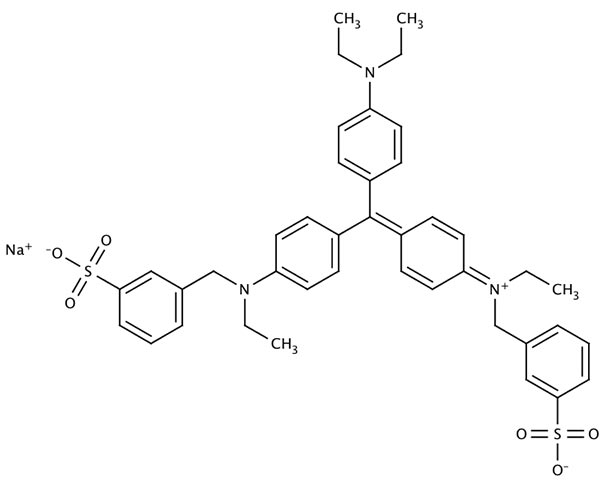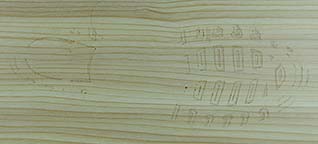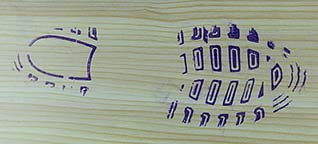On what surfaces can it be used
Acid Violet 17 (AV17) is a dye solution based on a water/acetic acid/ethanol mixture that is used for staining fingerprints and shoeprints made in blood [1]. Prints in blood are colored purple after treatment with Acid Violet 17 (similar color as LCV or Coomassie Blue). Acid Violet 17 can be used on absorbent surfaces but will stain the background. The CAST manual suggests to test a small part of the item away from the mark with Amido Black and AV17 to see which one gives less background staining.
Acid Violet 17 can be used after Acid Yellow 7 but may show less contrast than would be obtained with AV17 alone.
Before staining, prints in blood should be fixed to prevent them from running (causing loss of detail) when the staining solution is applied. In general fixative is applied before any staining solution except Leuco Crystal Violet, which contains fixative.
How to fix the prints
Fixing is best done with a 2% solution of sulfosalicylic acid in water (20-23 gram in 1 liter). To make sure the print in blood is thoroughly fixed, we recommended the following method using absorbent paper (like filter paper, tissue paper, or paper towels) and a wash bottle containing sulfosalicylic acid solution.
Take a dry piece of the absorbent paper that is sized to cover the print(s). Hold it directly over the print-area, parallel to the surface and just slightly above the surface. To begin fixing, drop one edge of the paper to the surface and moisten heavily along its entire length, so that it is anchored and will stay in place.
Starting from that edge, wet the paper progressively further while smoothing the wetted part onto the print and minimizing trapped air bubbles. Work carefully from one edge to the other. When possible, for example, with an object or with a print on an angled surface start from the top and work downwards.
Once the wet paper entirely covers the print, leave it there for a minimum of three minutes.When the blood is a thick layer, leave the paper there 5 minutes or more. Remove the paper. An excess of fixative can be rinsed away with water, but this is not necessary.
When the blood is relatively fresh, you will notice that fixing changes its color from dark red to dark brown.
Staining procedure
Once the print is fixed, it can be stained with Acid Violet 17 solution. Use a wash bottle or the spray bottle in which it is supplied to apply the solution to the article or area of interest. With fingerprints, a disposable pipet can be used. Alternatively you can submerge the article in a container/bath of solution if the size of the article permits.
Spraying is technically feasible but will likely raise the amount of ethanol vapor in the air. Sufficient protection measures should be taken to avoid inhalation of aerosols.
After the staining solution is applied leave it in contact with the print for 1-3 minutes. Then wash the surface with the same water/acetic acid/ethanol mixture as used for the dye solution, but without the dye.
Alternatively, water can be used but may result in more background staining. If the print is located on a floor, the wash solution might be removed with a vacuum cleaner that can handle water. Otherwise, remove it with paper towels or the like.
Lifting and fluorescence
Acid Violet 17 can be lifted with a white gelatin lifter (takes much more time than Acid Yellow 7 - around 15 minutes instead of a few minutes with AY7.) The stained prints will fluoresce when excited with green light though the fluorescence will often be faint. To obtain the best result, eliminating backgrounds and/or background fluorescence, stained prints can be lifted with a white BVDA Gellifter.
Before lifting with the white Gellifter, the area should be completely dry. Be very careful not to trap air bubbles under the lifter surface. Leave the lifter on the print for quite some time, something like 15 minutes. Photograph within a couple of hours after lifting as the dye will slowly diffuse in and across the surface of the lifter, thereby blurring the print.
Lifting can be done more than once, with or without re-staining between lifts. Repeat lifting/staining in important cases.
Fluorescence is excited with green light (480-545 nm). A red filter is used in front of the lens.
Safety
Acid Violet 17 powder is not labeled as a hazardous preparation. Since its working solution is based on a water/ethanol mixture, no harmful fumes are liberated in normal use, although the acetic acid smell might be irritating. When large amounts are used and/or the temperature is high enough, a potentially explosive air/ethanol vapor mixture can result unless sufficient ventilation is provided. Acid Violet 17 solution will color the skin and clothing.
Sulfosalicylic acid crystals are labeled as an irritant substance but the 2% solution is not labeled as a hazardous product. Given the fixative effect on blood, we strongly advise wearing gloves (vinyl gloves will suffice) when using it. Wearing protective goggles is not a bad idea either.
Avoid breathing aerosols (mists) and vapors of the fixative, washing liquid, and Acid Violet 17 solution. Likewise avoid contact with solutions and the Acid Violet 17 powder. Wash your hands after each session, especially before eating or drinking.
Composition of the solutions
Acid Violet 17
| 1 gram | Acid Violet 17 |
| 50 ml | acetic acid (glacial, 99%) |
| 250 ml | ethanol (98% or higher) |
| 700 ml | demineralized or distilled water |
| -------- | |
| 1000 ml | working solution |
Preferably use an Erlenmeyer flask for preparation of the Acid Violet 17 solution. Add water first and dissolve the Acid Violet 17 powder in the water by swirling the flask or using a magnetic stirrer and a PTFE-covered stir bar. The powder will dissolve quickly but due the strong color of the solution this will be hard to see. Allow enough time to dissolve all the dye. Then add ethanol and acetic acid (order not important.) Dissolving the Acid Violet 17 first in the ethanol/acetic acid mixture and then diluting it with water is also possible (as is dissolving it in the complete mixture of course.)
Blood fixative
| 20-23 grams | 5-Sulfosalicylic acid, dihydrate |
| 1000 ml | demineralized or distilled water |
| -------- | |
| 1000 ml | working solution |
Add components to a beaker/flask of suffient size and mix till complete dissolution, using a magnetic stirrer.
Washing solution
| 50 ml | acetic acid (glacial, 99%) |
| 250 ml | ethanol (98% or higher) |
| 700 ml | demineralized or distilled water |
| -------- | |
| 1000 ml | washing solution |
References and footnotes
[1] Sears, V.G.; Butcher, C.P.G.; Prizeman, T.M. "Enhancement of Fingerprints in Blood - Part 2: Protein Dyes" Journal of Forensic Identification 2001, Vol. 51, No. 1, p. 28-38.

Name: Acid Violet 17, CI 42650, Coomassie Violet R-150, Benzenemethanaminium, N-[4-[[4-(diethylamino)phenyl][4-[ethyl[(3-sulfophenyl)methyl]amino]phenyl]methylene]-2,5-cyclohexadien-1-ylidene]-N-ethyl-3-sulfo-, inner salt, sodium salt (1:1)
CAS No.: 4129-84-4









